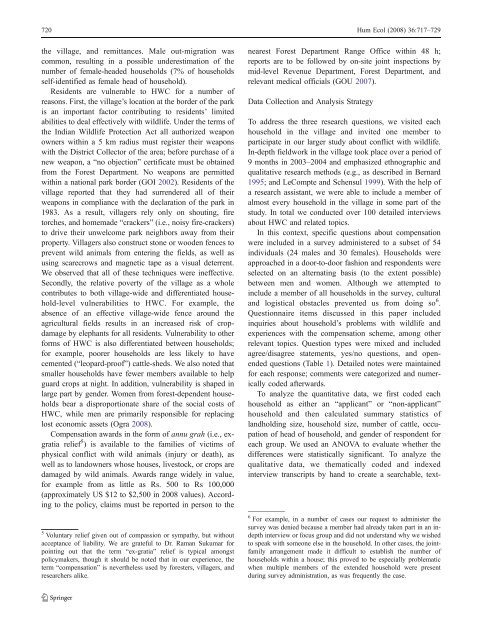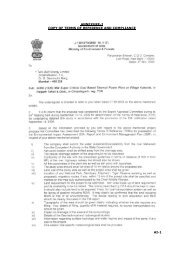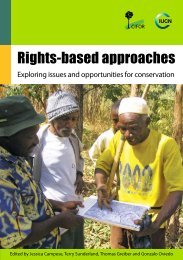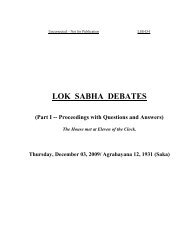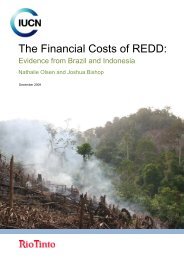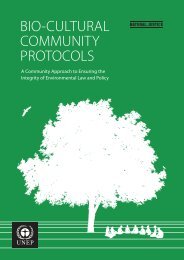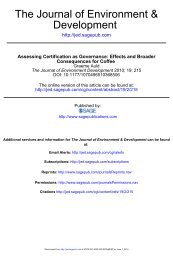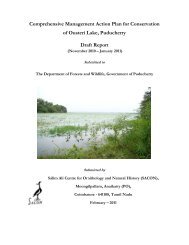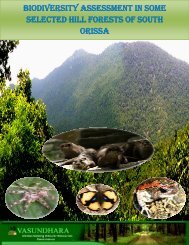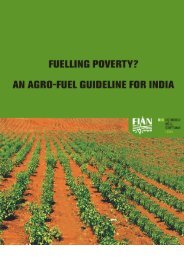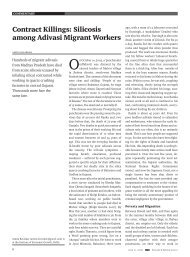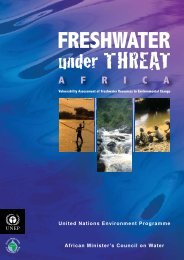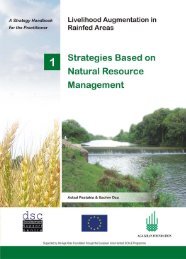Compensating Human–Wildlife Conflict in Protected Area - India ...
Compensating Human–Wildlife Conflict in Protected Area - India ...
Compensating Human–Wildlife Conflict in Protected Area - India ...
You also want an ePaper? Increase the reach of your titles
YUMPU automatically turns print PDFs into web optimized ePapers that Google loves.
720 Hum Ecol (2008) 36:717–729<br />
the village, and remittances. Male out-migration was<br />
common, result<strong>in</strong>g <strong>in</strong> a possible underestimation of the<br />
number of female-headed households (7% of households<br />
self-identified as female head of household).<br />
Residents are vulnerable to HWC for a number of<br />
reasons. First, the village’s location at the border of the park<br />
is an important factor contribut<strong>in</strong>g to residents’ limited<br />
abilities to deal effectively with wildlife. Under the terms of<br />
the <strong>India</strong>n Wildlife Protection Act all authorized weapon<br />
owners with<strong>in</strong> a 5 km radius must register their weapons<br />
with the District Collector of the area; before purchase of a<br />
new weapon, a “no objection” certificate must be obta<strong>in</strong>ed<br />
from the Forest Department. No weapons are permitted<br />
with<strong>in</strong> a national park border (GOI 2002). Residents of the<br />
village reported that they had surrendered all of their<br />
weapons <strong>in</strong> compliance with the declaration of the park <strong>in</strong><br />
1983. As a result, villagers rely only on shout<strong>in</strong>g, fire<br />
torches, and homemade “crackers” (i.e., noisy fire-crackers)<br />
to drive their unwelcome park neighbors away from their<br />
property. Villagers also construct stone or wooden fences to<br />
prevent wild animals from enter<strong>in</strong>g the fields, as well as<br />
us<strong>in</strong>g scarecrows and magnetic tape as a visual deterrent.<br />
We observed that all of these techniques were <strong>in</strong>effective.<br />
Secondly, the relative poverty of the village as a whole<br />
contributes to both village-wide and differentiated household-level<br />
vulnerabilities to HWC. For example, the<br />
absence of an effective village-wide fence around the<br />
agricultural fields results <strong>in</strong> an <strong>in</strong>creased risk of cropdamage<br />
by elephants for all residents. Vulnerability to other<br />
forms of HWC is also differentiated between households;<br />
for example, poorer households are less likely to have<br />
cemented (“leopard-proof”) cattle-sheds. We also noted that<br />
smaller households have fewer members available to help<br />
guard crops at night. In addition, vulnerability is shaped <strong>in</strong><br />
large part by gender. Women from forest-dependent households<br />
bear a disproportionate share of the social costs of<br />
HWC, while men are primarily responsible for replac<strong>in</strong>g<br />
lost economic assets (Ogra 2008).<br />
Compensation awards <strong>in</strong> the form of annu grah (i.e., exgratia<br />
relief 5 ) is available to the families of victims of<br />
physical conflict with wild animals (<strong>in</strong>jury or death), as<br />
well as to landowners whose houses, livestock, or crops are<br />
damaged by wild animals. Awards range widely <strong>in</strong> value,<br />
for example from as little as Rs. 500 to Rs 100,000<br />
(approximately US $12 to $2,500 <strong>in</strong> 2008 values). Accord<strong>in</strong>g<br />
to the policy, claims must be reported <strong>in</strong> person to the<br />
5 Voluntary relief given out of compassion or sympathy, but without<br />
acceptance of liability. We are grateful to Dr. Raman Sukumar for<br />
po<strong>in</strong>t<strong>in</strong>g out that the term “ex-gratia” relief is typical amongst<br />
policymakers, though it should be noted that <strong>in</strong> our experience, the<br />
term “compensation” is nevertheless used by foresters, villagers, and<br />
researchers alike.<br />
nearest Forest Department Range Office with<strong>in</strong> 48 h;<br />
reports are to be followed by on-site jo<strong>in</strong>t <strong>in</strong>spections by<br />
mid-level Revenue Department, Forest Department, and<br />
relevant medical officials (GOU 2007).<br />
Data Collection and Analysis Strategy<br />
To address the three research questions, we visited each<br />
household <strong>in</strong> the village and <strong>in</strong>vited one member to<br />
participate <strong>in</strong> our larger study about conflict with wildlife.<br />
In-depth fieldwork <strong>in</strong> the village took place over a period of<br />
9 months <strong>in</strong> 2003–2004 and emphasized ethnographic and<br />
qualitative research methods (e.g., as described <strong>in</strong> Bernard<br />
1995; and LeCompte and Schensul 1999). With the help of<br />
a research assistant, we were able to <strong>in</strong>clude a member of<br />
almost every household <strong>in</strong> the village <strong>in</strong> some part of the<br />
study. In total we conducted over 100 detailed <strong>in</strong>terviews<br />
about HWC and related topics.<br />
In this context, specific questions about compensation<br />
were <strong>in</strong>cluded <strong>in</strong> a survey adm<strong>in</strong>istered to a subset of 54<br />
<strong>in</strong>dividuals (24 males and 30 females). Households were<br />
approached <strong>in</strong> a door-to-door fashion and respondents were<br />
selected on an alternat<strong>in</strong>g basis (to the extent possible)<br />
between men and women. Although we attempted to<br />
<strong>in</strong>clude a member of all households <strong>in</strong> the survey, cultural<br />
and logistical obstacles prevented us from do<strong>in</strong>g so 6 .<br />
Questionnaire items discussed <strong>in</strong> this paper <strong>in</strong>cluded<br />
<strong>in</strong>quiries about household’s problems with wildlife and<br />
experiences with the compensation scheme, among other<br />
relevant topics. Question types were mixed and <strong>in</strong>cluded<br />
agree/disagree statements, yes/no questions, and openended<br />
questions (Table 1). Detailed notes were ma<strong>in</strong>ta<strong>in</strong>ed<br />
for each response; comments were categorized and numerically<br />
coded afterwards.<br />
To analyze the quantitative data, we first coded each<br />
household as either an “applicant” or “non-applicant”<br />
household and then calculated summary statistics of<br />
landhold<strong>in</strong>g size, household size, number of cattle, occupation<br />
of head of household, and gender of respondent for<br />
each group. We used an ANOVA to evaluate whether the<br />
differences were statistically significant. To analyze the<br />
qualitative data, we thematically coded and <strong>in</strong>dexed<br />
<strong>in</strong>terview transcripts by hand to create a searchable, text-<br />
6 For example, <strong>in</strong> a number of cases our request to adm<strong>in</strong>ister the<br />
survey was denied because a member had already taken part <strong>in</strong> an <strong>in</strong>depth<br />
<strong>in</strong>terview or focus group and did not understand why we wished<br />
to speak with someone else <strong>in</strong> the household. In other cases, the jo<strong>in</strong>tfamily<br />
arrangement made it difficult to establish the number of<br />
households with<strong>in</strong> a house; this proved to be especially problematic<br />
when multiple members of the extended household were present<br />
dur<strong>in</strong>g survey adm<strong>in</strong>istration, as was frequently the case.


